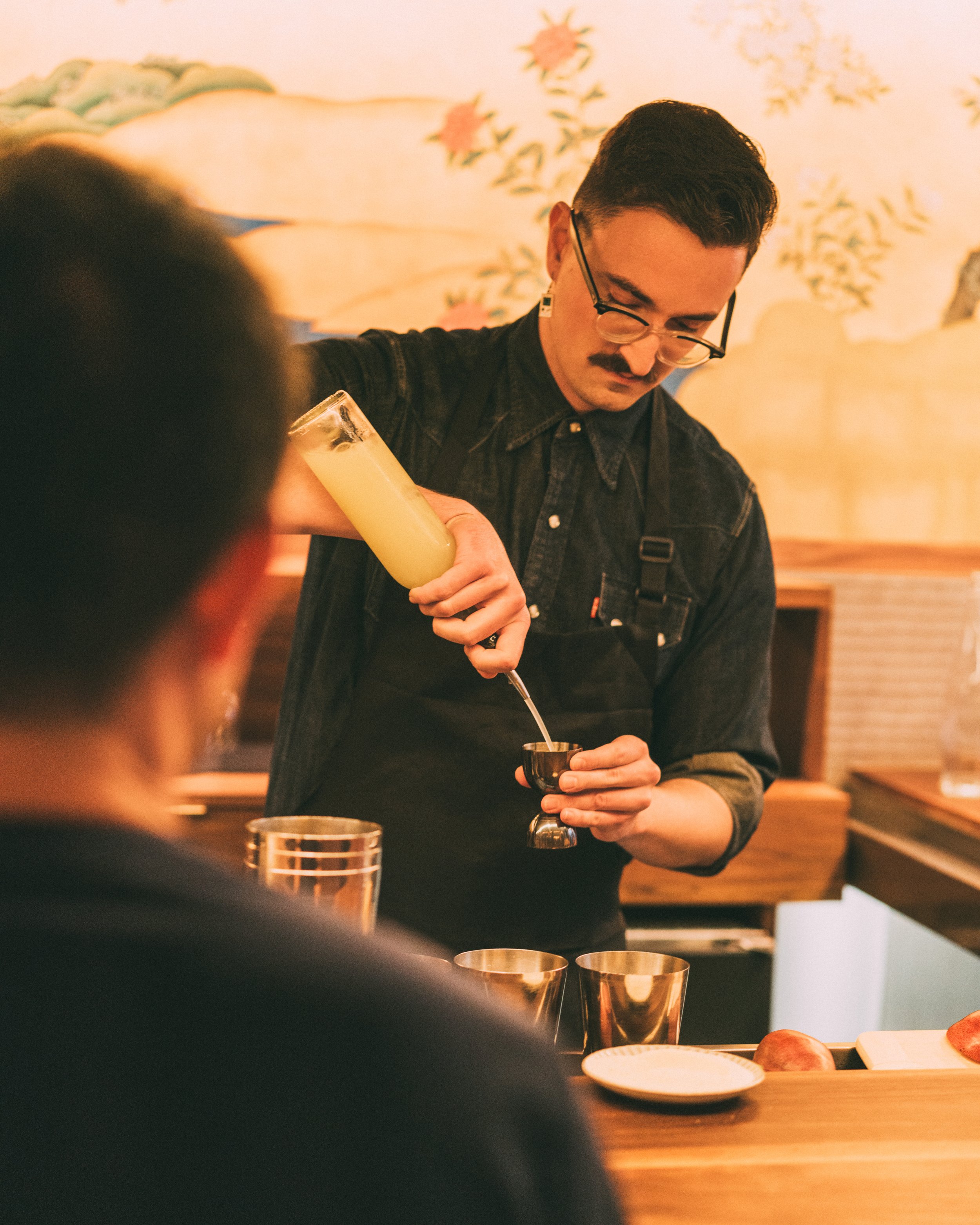Introducing Shochu to American Cocktails
By Kyle Davis
I started bartending in college about 11 years ago. I’m from Utah, where the liquor selection is very slim due to the restrictive (Mormon) liquor laws, so I didn’t find Shochu until I visited Japan in 2019 - I love trying local spirits, so I just pointed to something I was unfamiliar with on a menu, and was served an Oyuwari. It was a rainy day in March, so the lightly sweet, floral imo with hot water really comforted me and opened up my palette beautifully for the izakaya food we were enjoying.
Fast forward to 2021, I’m living in NYC and began bartending at a Japanese restaurant called Rule of Thirds. The bartender that trained me, Anna Archibald, showed me how many different kinds of Shochu exist and how different and unique each one was. Shochu is just the Japanese word for liquor and can be made from anything that can ferment, though the most popular are Sweet Potato (Imo), Barley (Mugi), and Rice (Kome). I was a former Mezcal devotee, and seeing how similarly expressive, versatile, and savory this new spirit category could be, but so broadly different, completely shook what I understood about bartending.
I’ve worked mostly with Honkaku Shochu, or traditional, single distillation Shochu, so I’ll be speaking on that. It’s a spirit that really tells the flavor story of the grain, root, or grass that it comes from - and koji (the fungus that assists in the fermentation process) frames and precisely highlights the tasting notes that the Toji (head distiller) wants it to - similar to Japanese whisky, Honkaku Shochu is a testament to how the Japanese have mastered the science of flavor.
Because of this, when I make cocktails with Shochu, I find a more culinary approach works perfectly with the spirit. Almost like making dashi or a sauce, different Shochu can give great structure and balance a drink with adaptability that simply isn’t seen in any other spirits. I like to ask my coworkers what kind of cereal is their favorite and recreate that profile by mixing different Shochu - sweet potato distillates lend to fruity cereals very well, while roasted barley Shochu can give a savory and earthy quality to a cereal cocktail with a maltier, bolder flavor. Sesame Shochu can make a cocktail taste like peanuts; black sugar Shochu can make it taste like creme brulée - you get the picture.
My signature drinks usually have a savory component in them as well, like miso, Japanese curry, or yuzu koshō. Japanese cuisine is a perfect balance of savory and sweet components, and it’s taught me a lot about my philosophy of flavor in cocktails.
Often with guests, I sense some confusion about what Shochu is - I went through a similar learning curve with it. I mostly get people who assume it’s going to taste like green apple Soju they had at karaoke in Koreatown once, or perhaps a hip flask of Baijiu they got at a corner store in Chinatown - but I find people are most open to it if I guide them based on the spirits they already know and enjoy, especially if you do a split base and modify the drink flavors they're familiar with. For example, a certain negroni variation has been trending, so I encourage my guests to try it with a bit of Mugi to balance out the sweetness of the Campari and vermouth.
Similarly, directing mezcal or whiskey lovers to a spirit like Aokage (smoky, earthy, nutty) or gin lovers to a delicate, floral Imo (like Jikuya White) is a great stepping stone to introduce people to a new type of spirit and demonstrating how different it is from its Korean and Chinese counterparts.
I find giving Shochu a place and a story can also help make it distinct, like the badass 96-year-old Motoko from the Furusawa Distillery - as far as history tells, she’s the first female Toji in Miyazaki, and has passed down her knowledge and mastery to her daughter and granddaughter. Or with Aokage, where the Toji has rigged his machinery to roast the barley as it’s being distilled and only strains out impurities with a horsehair brush.
Introducing people to the spirit can also be as simple as substituting it into a classic cocktail - though this has some caveats. Many Shochu are sold at 25 percent alcohol by volume (ABV), so if you "Frankenstein" it into a classic, spirit-forward cocktail, it might fall flat - I’d recommend sticking with a 40ish ABV Shochu for this approach. I produce and star in a drag show at my current restaurant, and this can be as easy as convincing someone to branch out to a Shochu Highball (Sodawari) after their first Vodka Soda.
I’m helping Brooklyn Kura open a new taproom showcasing house-made sakes and shochu cocktails from various distillers, and I can’t wait to help introduce this spirit to New York City. I’m truly convinced that the Shochu renaissance in the states is going to be as big and influential as Mezcal was (and continues to be). I’m not Japanese, nor am I trying to make my new cocktail program traditional or appropriative. Rather, I’m trying to take the lessons that I’ve learned from the Japanese culinary approach to balance and highlight this unique and versatile liquor. My goal with my new bar is to showcase how approachable, chameleonic, yet distinct, Shochu is and how it can play with a variety of flavors I’ve grown up with in my family - Welsh, Mexican, American, and infinite others.
Kyle Davis is an award-winning bartender living and working in Brooklyn, NY.


